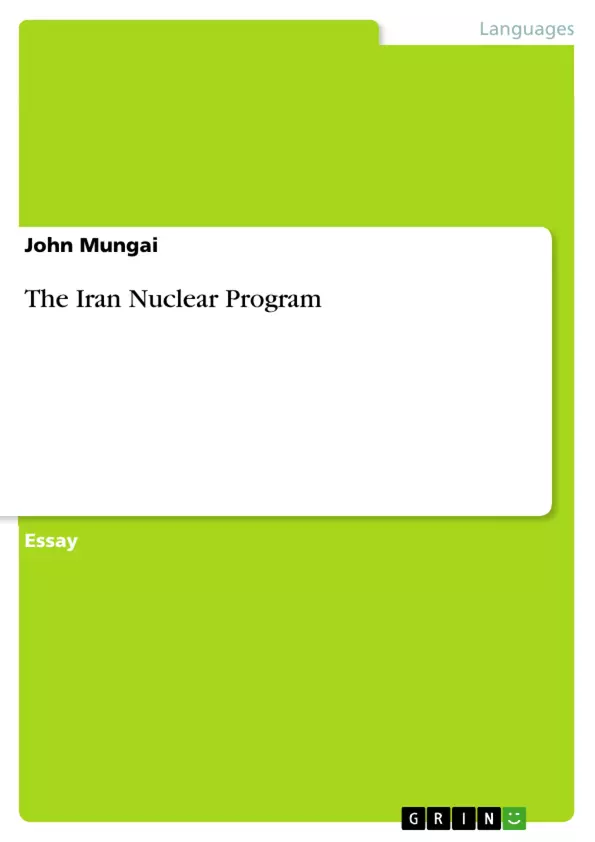Iran nuclear threat continues to bring the world tension over the harshness and aggressiveness of the nation. The country has often made efforts to start a war within the region, and with it as a source of worlds energy through oil, it is a concern when it continues to threaten the peace and stability of the entire world. A large number of treaties have been put in place to attempt to help the situation such as the signing of various deals over the years to ensure peaceful co-existence, but the present action by the US government to withdraw from the Iran Deal threatens the continued stability within the region after several years. Iran has been able to threaten several countries within the area including stating an explicit threat to US allies such as Israel. The threat negatively indirectly influences the US as the country relies on Iran as a source of energy. Therefore, attempts to understand the role of US and other nations within the region towards eliminating the threat of Iran nuclear requires a deep understanding of the Iran nuclear program, the impact of US withdrawal from the JCPOA agreement and measures to deter the country from the acquisition of nuclear weapons.
Inhaltsverzeichnis (Table of Contents)
- Iranian Nuclear Program
- U.S. Withdrawal from the JCPOA Agreement
- Deterring Iran from Acquiring the Nuclear Weapon
- Role of the U.S. and its Partners in Managing the Iranian Nuclear Threat
Zielsetzung und Themenschwerpunkte (Objectives and Key Themes)
This paper examines the escalating tension between the United States and Iran surrounding Iran's nuclear program, highlighting the challenges and implications arising from the US withdrawal from the Joint Comprehensive Plan of Action (JCPOA) agreement. The paper delves into the history and development of Iran's nuclear program, analyzes the consequences of US withdrawal, and explores measures aimed at deterring Iran from acquiring nuclear weapons.
- The history and development of Iran's nuclear program
- The impact of the US withdrawal from the JCPOA agreement
- Measures to deter Iran from acquiring nuclear weapons
- The role of the US and its partners in managing the Iranian nuclear threat
- The international response to Iran's nuclear program
Zusammenfassung der Kapitel (Chapter Summaries)
Iranian Nuclear Program
The Iranian nuclear program has been a source of global concern for decades, dating back to the 1950s when the US provided technical assistance to the Shah of Iran. This assistance, coupled with Iran's own investments, facilitated the development of its nuclear program, culminating in the revelation of undeclared facilities in 2002. The subsequent imposition of sanctions ultimately led to the creation of the JCPOA.
U.S. Withdrawal from the JCPOA Agreement
The US withdrawal from the JCPOA agreement in 2018 has significantly exacerbated tensions in the region. The withdrawal jeopardized the deal's success and has put a hold on international trade and investment with Iran. While Iran claims to remain committed to the agreement, the US re-imposition of sanctions has heightened the risk of regional instability and conflict.
Deterring Iran from Acquiring the Nuclear Weapon
The JCPOA aimed to limit Iran's nuclear capabilities through various mechanisms, including limiting its access to enriched uranium, blocking the production of weapons-grade plutonium, and implementing rigorous inspections. However, the US withdrawal has cast doubt on the efficacy of these measures, leaving the possibility of unilateral military action by Israel as a potential response to any perceived threat.
Schlüsselwörter (Keywords)
The key focus of this analysis is on the complex interplay of Iran's nuclear program, the US withdrawal from the JCPOA, and international efforts to deter Iran from developing nuclear weapons. This involves considering various key concepts such as regional stability, nuclear proliferation, international sanctions, and the role of key actors like the US, Iran, Israel, and Saudi Arabia.
- Quote paper
- John Mungai (Author), 2019, The Iran Nuclear Program, Munich, GRIN Verlag, https://www.hausarbeiten.de/document/458829


